As Valentine's Day is upon us it's essential to remember that the foundation of all love starts with ourselves. Valentine’s Day for me is synonymous with the red foil chocolate hearts. Yum, I loved eating those hearts and am still partial to them. But for the sake of this blog, let's leave the chocolates, flowers and cupid’s arrow at the door and shift the focus from external validations to internal nourishment and well-being. We have the power to cultivate improved feelings from within. A balanced, nutrient-rich diet plays a pivotal role in supporting brain function, influencing mood, and overall mental health. As you may guess, for me one food group stands out for its potential to positively impact mental well-being: beans.
Rich in essential nutrients like magnesium, folate, iron, zinc, and fiber, these legumes support brain chemistry and neurotransmitter function, which are fundamental to mood regulation and cognitive processes. While you all know my favorite varieties come from Rancho Gordo, for this post I will discuss easy-to-procure supermarket beans, from black beans to the versatile kidney bean, how each brings a unique set of nutrients that can contribute to a happier, healthier mind.
To make it easier I have matched a bean for each mineral or vitamin that is closely associated with it. However, if you eat beans and lentils with a variety of diverse veggies and grains, you cannot go wrong as far as improving your overall mood, health and well being. Lets begin:
Magnesium in black beans: Anxiety reduction and sleep improvement
You can’t go onto any social media platform without hearing about the benefits of magnesium; new products are being sold and there are quite a few accounts who are sharing information with us. Fortunately it’s a key mineral, abundantly found in black beans, plays a vital role in our mental health, particularly in reducing anxiety and enhancing sleep quality. Magnesium helps to calm our nervous system, making it easier to manage stress and anxiety. It also contributes to muscle relaxation, which can lead to improved sleep quality. When I first started eating beans I noticed my sleep improved but I was so busy working on my gut health I took my sleep for granted. It was only over the course of time that I have been experimenting with many different legumes in my meals that I fully appreciated my beans. By incorporating black beans into our diet, we provide our bodies with a natural source of magnesium, aiding in the reduction of anxiety levels and promoting restful sleep, both of which are essential for optimal mental health.
Folate in lentils: Brain function and depression combat
Folate, a B vitamin plentiful in lentils, is critical for healthy brain function and plays a significant role in combating depression. Folate contributes to the creation of DNA and RNA, the building blocks of cells, and is essential for the metabolism of the amino acid homocysteine. When I was pregnant years ago I took a folic acid supplement every day. It is recommended for women planning on getting pregnant to be sure to have enough folate daily. The Mayo Clinic explains the difference between eating foods that naturally have folate versus taking a synthetic supplement. High levels of homocysteine have been linked to an increased risk of depression. Folate helps to regulate homocysteine levels, thereby reducing this risk. Additionally, folate is involved in the synthesis of neurotransmitters such as serotonin, dopamine, and norepinephrine, which influence mood, appetite, and sleep. Adequate intake of folate from lentils can support brain health, improve mood, and help prevent depressive symptoms. I have many lentil recipes on this blog that can provide a diet rich in folate naturally, if this is something that interests the reader.
Iron in kidney beans: Combating fatigue and enhancing cognitive function
Iron, a critical nutrient found in kidney beans, is essential for combating fatigue and improving cognitive function. Iron is a key component of hemoglobin, the protein in red blood cells that carries oxygen to the body's tissues, including the brain. Adequate iron levels are necessary for optimal brain oxygenation, which supports cognitive functions such as memory, concentration, and learning. The bioavailability of iron from plant sources (non-heme iron) is lower than from animal sources (heme iron), but consuming vitamin C-rich foods alongside beans can enhance iron absorption. The National Institute of Health has multiple studies that show eating foods high in vitamin C help with the absorption of iron. Foods high in vitamin C include dark green leafy vegetables, bell peppers, melons, strawberries, pineapple and kiwi.
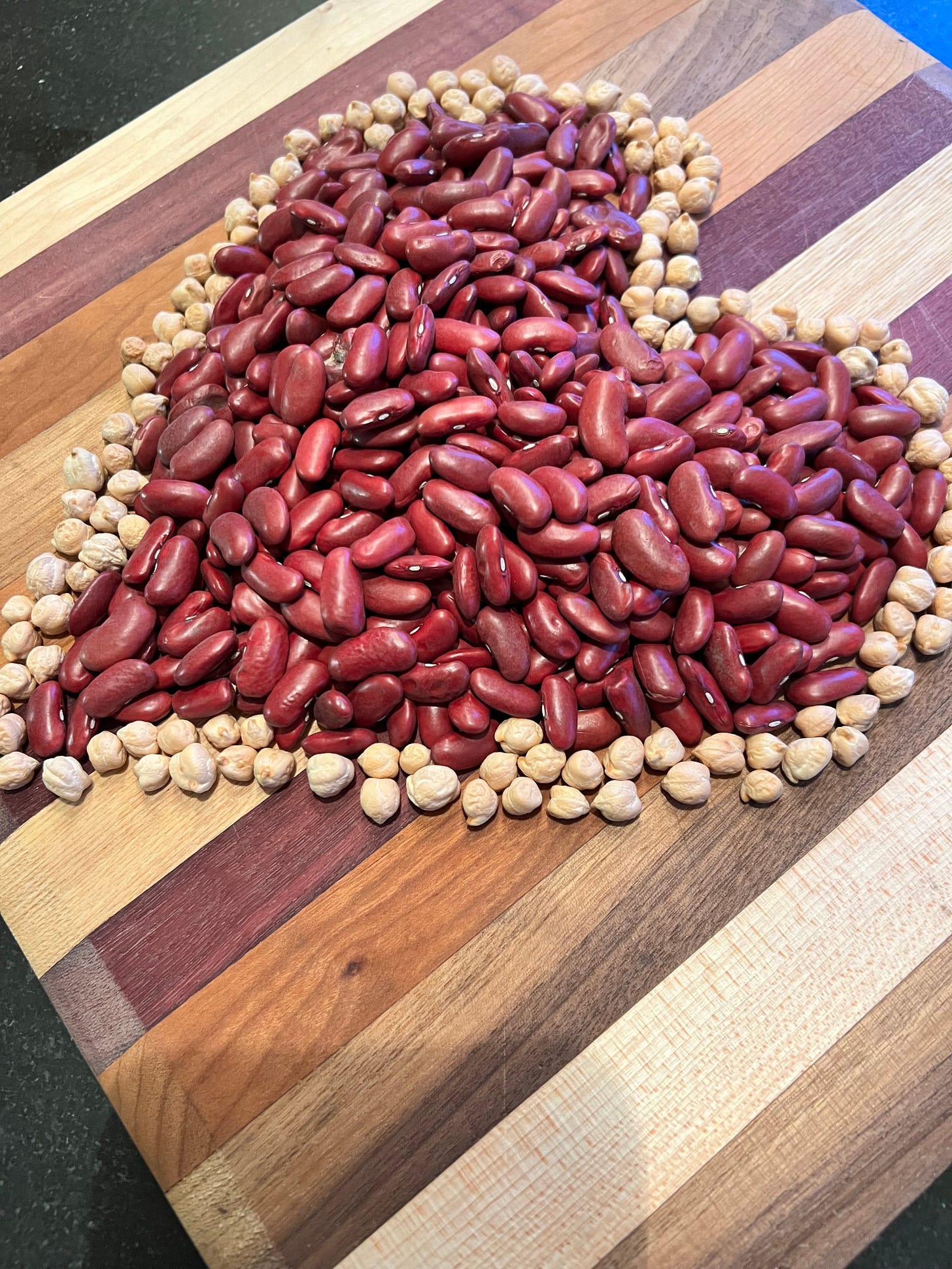
Zinc in chickpeas: Stress management and mood boost
Zinc is a mineral with a significant impact on managing stress and boosting mood. It plays a crucial role in the neurological system and in the regulation of neurotransmitter pathways, including those that govern the body's response to stress. It's also involved in the function of the hypothalamic-pituitary-adrenal (HPA) axis, which regulates the body's stress response. Adequate levels of zinc can help in moderating this response, reducing the effects of stress on the body and mind. Eating the chickpeas is part of a wider response to healthy living. If we are working 60 hour weeks, not getting enough sleep and canceling our social engagements with our close friends there is only so much the zinc in chickpeas can do. Yes, zinc has been linked to mood regulation, with deficiencies often associated with mood disorders such as depression. Incorporating zinc-rich foods like chickpeas into our diets can support our body's stress management systems and contribute to a more positive mood as long as we are also taking care to balance our schedule and our boundaries.
Fiber in beans: Gut health and mood regulation
The high fiber content in beans plays a crucial role in influencing gut health, which is directly related to mood regulation through the gut-brain connection. Dietary fiber helps to promote a healthy digestive system by supporting the growth of beneficial gut bacteria. I have written extensive regarding beans, their soluble fiber and gut health. Furthermore, a healthy gut microbiome is essential for the synthesis of neurotransmitters, such as serotonin, which is predominantly produced in the gut, in our intestines. Serotonin is a key neurotransmitter in mood regulation, and its production is greatly influenced by the state of our gut health. By consuming a diet high in fiber from beans, we can support our gut microbiome, thereby positively influencing our mood and overall mental well-being.
Consuming beans has many wonderful physical and mental health benefits. This week I enjoyed showcasing the natural ways we can absorb the nutrients our bodies need to sustain our wellbeing. Being mindful of the other pillars such as sleep, movement, and connecting with friends and family, will help us in boosting our health over the winter months when our bodies need all the assistance we can get to stay ahead of the curve.
Remember, Start with Beans!
Recommended Recipe
Black bean soup (from Cucina Simpatico)
A veggie, black bean and quinoa salad was originally the recipe on the list for today but it seems like we should be creating this dish on a sunnier day. Yesterday, I made it, I ate it and it was delicious. But today in the Northeast we are getting hit with a coastal snowstorm. Instead let’s look to a cozy soup, like a dear friend, to cheer us up; it is easy to create all you need time and a bit of patience. Where I am there is time today, but if you don’t have that you can make the canned bean or jarred bean version. Whether you use dried beans or already prepared in a can beans you will still receive the benefits. I could do a blog post on black beans alone and their benefits. Yes magnesium as I stated above but so many other nutrients that are helpful in maintaining your health including healthy bones, too. This one is a keeper.
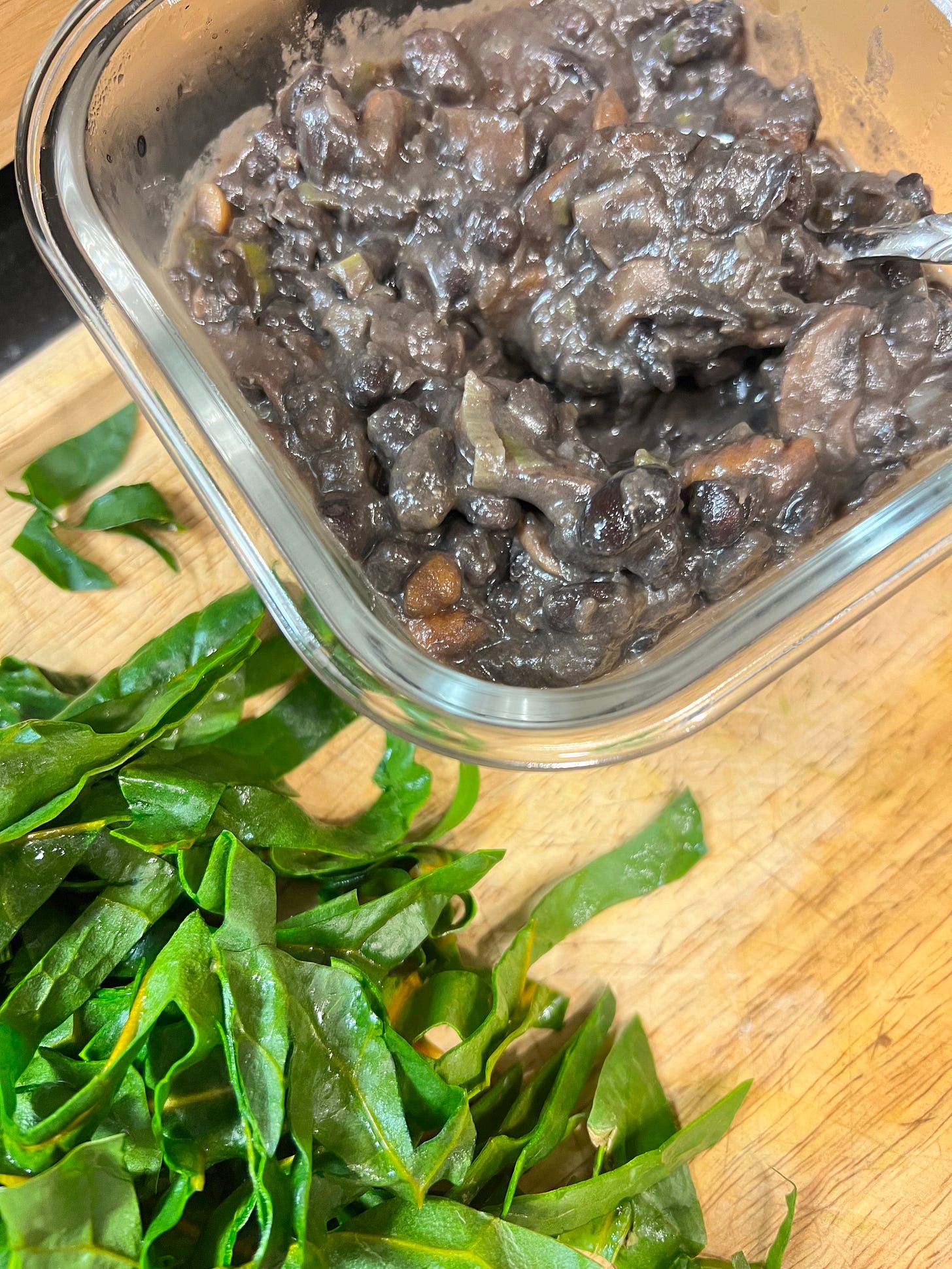
Ingredients
3 Tablespoons EVOO
2 C chopped onion
1 C chopped carrot
1 C chopped celery
2 Tbsp chopped garlic
2 jalapeño peppers, chopped, seeds removed (taste your peppers for heat, if you need more heat add more or add hot sauce at the end)
1 tsp kosher salt
1 pound black beans, (I soak over night to reduce cooking time) or 4, 15 oz cans of beans
1 lemon
6 sprigs of fresh rosemary
For serving:
Hot sauce (optional), roasted butternut squash toast on top or
avocado, cilantro and lime with corn bread
In a Dutch oven or heavy stockpot, heat the olive oil and add the onion, carrot, celery, garlic, jalapeños, rosemary and salt. Saute for approximately 10 minutes until veggies are softening.
Add the beans (I include the water they soaked in over night, adding that, too. It’s usually less than two cups because most of it was soaked into the beans.) Then, I add approximately 8 more cups of water. If you did not soak your beans, you will need to add 12 cups of water, bring it to a boil, and let it boil for 10 minutes. Next, turn it to a simmer until the beans are soft, another 1 to 1 1/2 hours depending on your beans. (If you are using Rancho Gordo beans you will only need around 45 minutes more.) If the soup is getting too thick, add more warm water.
2A. If using cans of beans instead of dry, add some water, likely veggie stock or combination of the two to a consistency that you would like~2-3 cups. Let it all simmer on low for 15 minutes to allow the veggies to infuse with the canned beans. You save yourself 45 minutes and it will be equally tasty.
Note 1: For both versions, I mash some of the beans with the back of the wooden spoon or a potato masher right in the Dutch oven to get a thickness in the soup that I prefer.
Note 2: For those using cans—If you rinse the beans to remove the additional salt, added your 2-3 cups water/stock, its simmering like a champ and your soup is still pretty thin after mashing from the note above then you may want to take a couple of ladles worth of the beans and veggies, with some water and/or stock from your soup pot and blend it in your blender. Then add the blended soup back to the stockpot and stir to incorporate. I include these notes for newer home cooks who are still learning their preferences when it comes to beans. If you know what you like, skip ahead. Cheers.Zest an entire lemon and add it to the soup. Do not include the bitter white pith. Taste your soup and adjust seasonings. I added cumin to mine because I like the taste. The original recipe from the Cucina Simpatico cookbook does not.
If you are making the butternut squash toasts, you will need to broil your bread, on both sides, rub with garlic cloves and top the bread with butter or olive oil and butternut squash. While the soup is simmering, I roast my squash in a 425 degree oven. Slice the squash down the middle, brush a small amount of olive oil, salt and pepper and place flat side down on a baking sheet on top of parchment or foil. Roast for 45 minutes until fork can pierce the skin easily. Let cool, scoop out the flesh and mash it with a fork or potato masher. Add salt and pepper and a little rosemary to taste. Top the toast with squash and you can heat through under a broiler or serve at room temp.
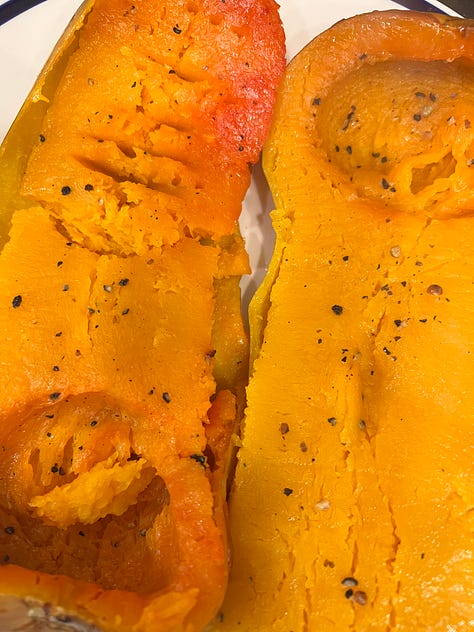
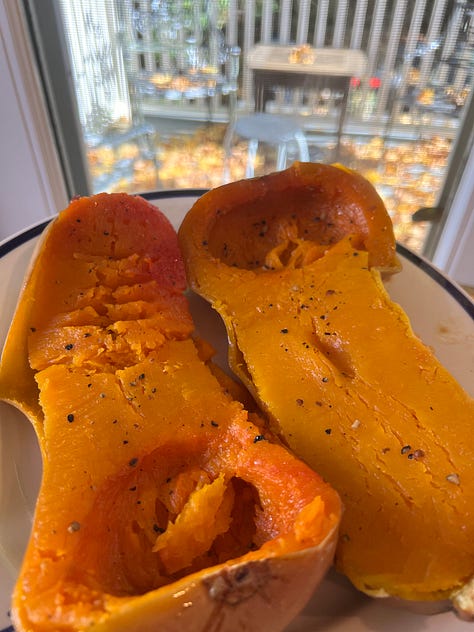
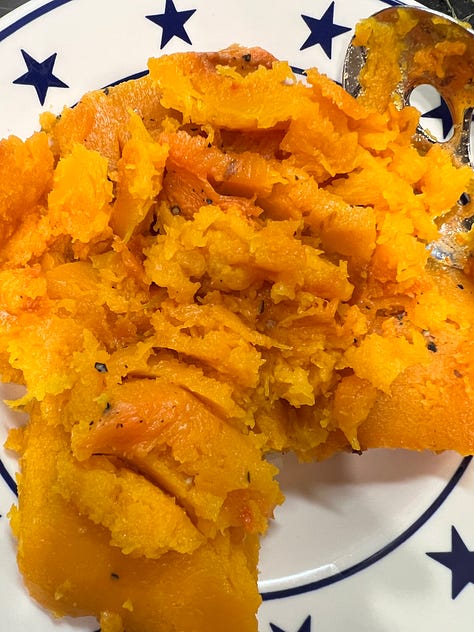
Butternut squash once removed from the oven and beginning to mash. Ladle the soup in bowls, place a squash toast on top with a squeeze of lemon. Alternatively, add sliced avocado, cilantro and a squeeze of lime with some corn bread.
Contact
If you have any questions on eating beans for their essential nutrients or integrating beans consistently for gut health now and into the near future, please email me at Denisemancieri1@gmail.com. Feel free to comment below if there are topics you would like to see.
Please share this newsletter with others if you find it may assist them in adding beans to their diet. Or click the heart, below left, so I know you were here. Thank you!
Note: I am not a doctor. I am a teacher and an educator with an earned doctorate in educational leadership. I enjoy research and I can distill large amounts of information into easily understood and digestible pieces allowing people to understand what is happening to their body and possible steps to reverse it with food as medicine. I have healed my own GI issues through choices with food. I followed Karen Hurd’s bean protocol diet, I meditated and still do and I healed. I feel compelled to be in service and educate others as the more people eating beans, alongside a healthy diet and sharing their stories the more people will live a healthier existence. Joy, peace and freedom abound. Please see your doctor and discuss nutritional options before you change any course of action with your health.




